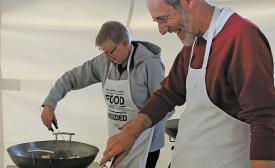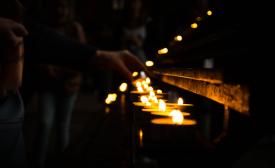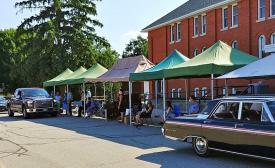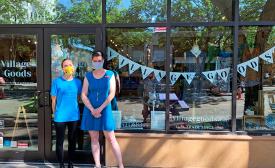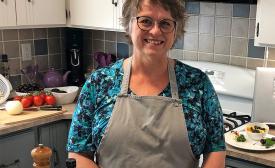Volume 24 Number 17
Potluck faith
Every year around this time, the congregation I belong to makes plans for Gathering Sunday. After a summer of sparser attendance at worship services, our gathering on the first Sunday after Labour Day is always a celebration, a reunion for those of us who vacationed outside the area and for those who stayed put during the summer.
Hooked on volunteering
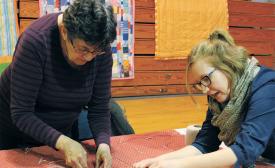
Marion Regier, left, and Rachel Wallace tie quilts together at MCC’s Great Winter Warm Up in Rosthern, Sask, in January 2020. (Photo by Donna Schulz)

Meaningful volunteer experiences help build community. Sarah Warkentin, left, Jessica Rorison and daughter Nyah, Vicky Stucky and Janet Regier tie a quilt at MCC’s Great Winter Warm Up in Rosthern in January 2020. (Photo by Donna Schulz)

Hertha Friesen and Edna Sagrott tie quilts together at MCC’s Great Winter Warm Up in Rosthern in January 2020. (Photo by Donna Schulz)
Eileen Klassen Hamm recalls how, as a young adult, she considered a Mennonite Voluntary Service term to be a good and natural thing to do.
Readers write: August 17, 2020 issue
Dandelion cover inspires flower arranger
Re: Dandelion front cover, June 8.
I laughed out loud when I saw the dandelion on the cover.
‘The long wait’
“There is a time for everything, and a season for every activity under heaven: A time to born and a time to die . . . .” (Ecclesiastes 2:1-2).
Volleyball game
The Conference of Mennonites in Canada annual session was held in July 1975, in Swift Current, Sask. Hot weather put participants’ “cool” to the test. The assembly was not only about business but also about relationships and, as such, there was time for work and play, including a game of volleyball, pictured.
Why ‘third way’?
I’ve been asked recently why my column is called “Third Way Family.” The question has prompted me to share my reasoning behind choosing this title and what it means to me.
The role of the church today?
I am listening these days to stories of how people and their churches are responding to the physical and emotional needs around them due to COVID-19. Every congregation is finding ways to help those around them who need food, assistance with their rent, connecting digitally or some other kind of accompaniment.
Antifragile church
The past few months have awakened us to our fragility as individuals, communities and nation states. We’ve observed the fragility of our health-care system, food-supply chain, economies, global trade, international relations, institutional accountability. It seems that everything in our world is fragile, including ourselves.
Western Christianity misinterprets Jesus
When H.S. Bender came out with The Anabaptist Vision in the 1940s, he offered a Mennonite theology that was different from the evangelical fundamentalism widely accepted in the church at the time.
'Butterfly whisperer' aids monarchs in Windsor
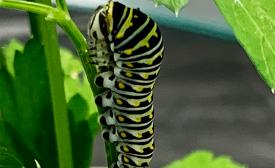
An eastern black swallowtail has just shed its skin and has moved to the next size of caterpillar. It will turn around and eat that skin before moving on to some parsley or dill. (Photo courtesy of Susan K. Harrison)
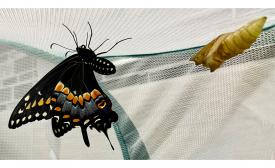
An eastern black swallowtail has just emerged from her cocoon (to her right). This was Susan K. Harrison’s first successful attempt to raise the insect from egg to butterfly. (Photo courtesy of Susan K. Harrison)
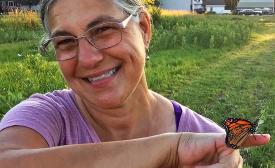
Harrison releases a monarch butterfly at a farm in LaSalle, Ont., where the owner, Dick Wood, has allowed the land to naturalize, nurturing biodiversity including monarch and swallowtail butterflies. (Photo courtesy of Susan K. Harrison)

‘The nursery’ in Harrison’s kitchen. Each cage has a test tube holder and tubes full of water that hold cuttings from milkweed that have monarch eggs or newborn caterpillars on them. The other tent has tubes of water holding cuttings of parsley with eastern black swallowtail eggs and newborn caterpillars on them. When they get old enough to pose a threat of eating the other eggs, they are moved to an outdoor cage, where they will eventually form their chrysalides. (Photo courtesy of Susan K. Harrison)
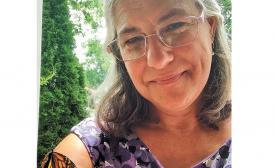
A newly released female monarch butterfly decides it is not ready to leave Harrison, so it walked up her arm and sat on her shirt for the rest of the afternoon. It flew away later that evening. (Photo courtesy of Susan K. Harrison)
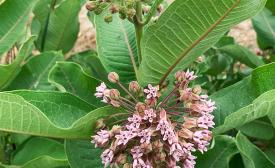
Monarch caterpillars can only eat milkweed, and they only lay their eggs on the milkweed plant. Without an available supply of milkweed, they are at risk of extinction. To Harrison, they are pretty plants that people who want to help the monarch survive can easily incorporate it into their gardens. (Photo courtesy of Susan K. Harrison)
The human impact on climate and the Earth itself can often be seen on a massive scale. Think of the melting Arctic or check out the photographic work of Ed Burtynsky.
But Susan K. Harrison, a hospice chaplain and psychotherapist in Windsor, Ont., is doing her part to help on a much smaller and more local scale.
Marking end-of-life rituals during the pandemic
Amid the restrictions of COVID-19, pastors and families are still finding creative and meaningful ways to mark, grieve and ritualize the deaths of loved ones. But no two funerals are the same, and there are added stressors, frustrations and disappointments.
Former Ten Thousand Villages stores in Alberta rebrand
“What would it take to stay open?” asked members of the Edmonton Ten Thousand Villages (TTV) Society after the organization announced its closure in early January. Independently owned stores across Canada held emergency meetings to decide what to do next.
Voices Together announces No. 1 hymn
As Voices Together nears publication, the Mennonite Worship and Song Committee editorial team has assigned the roughly 750 songs across the table of contents and selected the song that will appear first in the collection.
Oven Omelette popular with B&B guests
Do you love food? I do! My love of cooking and experimenting with food has led me to develop many of my own recipes. A few years ago, I typed up and printed out approximately a hundred of my recipes, placed them into binders and gave them to my seven children.
Jill’s Oven Omelette

When I serve omelettes to my bed and breakfast guests, I usually complete their plates with one slice of bacon, one piece of locally made “Mennonite sausage,” a small bowl of fresh fruit with yogurt and granola, and either a slice of whole grain toast or a small portion of homemade hash browned potatoes.
I developed this original recipe as part of a school nutrition program. Read the story behind the recipe here.
Ingredients
Echoes of history
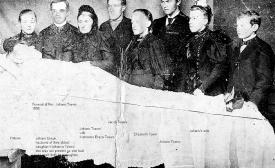
Funeral picture of Reverend Johann Toews Sr. (1845-1898). Third from right is Johann Toews, the letter writer; far right is Wilhelm Toews, who received the letters. Second from left is John Braun’s great-grandfather Johann Braun (1869-1922), whose wife Katharina Toews Braun is not pictured because she had just given birth. (Photo courtesy of John Braun)
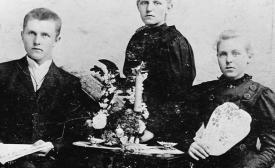
Johann Toews, the letter writer, left, and two of his sisters, Elisabeth Toews (1881-1922) and Helen Toews Letkemann (1879-1919). (Photo courtesy of John Braun)

Johann Toews, the letter writer, when he was sentenced to five years forced labour in exile. (Photo courtesy of John Braun)
When John Braun was contacted by a relative he didn’t know existed, it was the start of a long adventure into family history and an old language.



